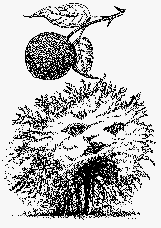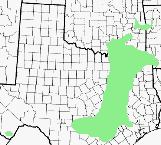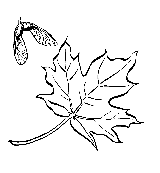



osage-orange
Maclura pomifera
Osage-orange, hedge, or Bois D'Arc is a small to medium, deciduous tree with a mature height of 20 to 50 feet with equal spread. This tree is appropriate for yards, parks, boulevards or anywhere a durable tree is desired. Native plants have numerous thorns and softball size fruits. The specie tolerates a wide range of soil and weather extremes. A few great male cultivars provide fruitless, nearly thronless choices. Look for 'Park', 'Wichita', and 'White Shield.'

Plant illustration by Dale Larison, Missouri Department of Conservation
Range map modified from USDA Forest Service Silvics of North America Web site - www.na.fs.fed.us/spfo/
pubs/silvics_manual/
Volume_2/maclura/
pomifera.htm
Chainsaw Safety and Pruning Workshop
- October 1, 2005
Safety is critical when operating any kind of equipment. Chainsaws are now a common tool and frequently used in unsafe ways. Safe use of this tool will be presented with some demonstrations. Tree pruning is a common way chainsaws are used. The proper way to prune branches, and the reasons for the method will also be presented and demonstrated.

|
The workshop will be held at Kellogg Lake east of Carthage off Hwy. 96 and run from 10:30 A.M. To 3:30 P.M. with a bean and cornbread lunch provided.
A $5 registration is required. Register at the Carthage Parks and Recreation Office in Municipal Park (521 Robert Ellis Young Dr., Carthage, MO 64836-3913, 417-237-7035). Make checks payable to Kellogg Lake Spring River Development. ISA CEU's are anticipated.
Missouri Community Forestry Council Photo Contest
Calling all photographers. MCFC and MDC are looking for images for the award plaque presented to Missouri Arbor Award of Excellence winners. The photo contest winner's image may be used as the focus of the award plaque.
Images must show the beauty and importance of trees along streets, in parks or yards. Landscape images of fields, woodlands, and pastures are not desired.
All submissions must be sent to Justine Gartner, Photo Contest Coordinator, MDC, P.O. Box 180, Jefferson City, MO 65102 and received by October 31, 2005. All submitted images become property of MDC and will not be returned.
For an entry form with a complete set of contest rules and requirements contact Jon Skinner ( Jon.Skinner@mdc.mo.gov, 417-629-3423) or download it at www.geocities.com/rocksandtrees/thestump/august2005/photocontest.pdf.
Know Your Trees

|
Late summer is a great time to practice your tree identification. You have all of the tree's signs to assist with determining the tree specie. The leaves, bark, some fruit, and buds are available by this time.
It is important to learn the differences between trees not just for fun, but to learn how the different trees grow, what kind of fruit it has, how it responds to different cultural practices like pruning, and what insects and diseases may affect it. For example, a silver maple is in a yard. This is a tree that grows fast, fairly tall, has surface roots, breaks and decays easily, sprouts readily, has seeds (kids call them helicopters) that start growing everywhere, and tolerates flooding. Compare that to a sugar maple which grows slower, fairly tall, has fewer surface roots, breaks only under great stress and decays slowly, sprouts are not common, has similar seeds that start growing much less often, and does poorly in areas that flood.
Though both trees are maples, they are quite different. Knowing these differences will affect how to treat them. Pruning should be done correctly on both, but on the silver maple you may be more aggressive in where to prune a branch for power line clearance than you would for the sugar maple due to the difference in growth rate. You may choose to not plant one or the other for a specific situation. Silver maple does great in a flood plain, where sugar maple does better above the flood plain.
There are several good references for identifying trees. They can be books, personal notes, or on the internet. They may have color images, black and white drawings, or just text descriptions. Find the one or ones that works best for you and get out and learn your trees.
Building for Greener Communities National Conference
Integrating green features into the infrastructure of a community creates a more pleasant place to live, work, and enjoy leisure time. Bringing a greener approach to the planning and management of our communities is the focus of this conference.
A key component of this greener approach is valuing the resources that are already in place. When trees and other natural features exist on land that is to be developed, it makes good sense, environmentally and economically, to preserve these assets whenever possible. The agenda of this conference will provide presentations addressing the nuts and bolts of retaining trees and other natural features during construction and development. In fact, you will see case studies detailing the work done by the development teams that won the 2005 Building With Trees Awards of Excellence.
Occurring September 19 - 21, 2005 at the Arbor Day Farm, Nebraska City, NE, the conference is for developers, planners, builders, and others involved in the development process. Registration is $350. To register and get more information about this workshop, visit the Arbor Day Conferences web site at: www.arborday.org/greenercommunities/.